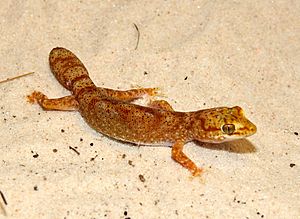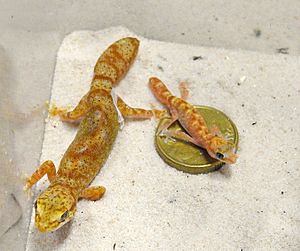Tessellated gecko facts for kids
Quick facts for kids Tessellated gecko |
|
|---|---|
 |
|
| Scientific classification | |
| Genus: |
Diplodactylus
|
| Species: |
tessellatus
|
The Diplodactylus tessellatus, also known as the tessellated gecko, is a small lizard. It lives on the ground in inland parts of New South Wales, Queensland, Northern Territory, South Australia, and the northwestern corner of Victoria. This gecko is one of 26 species in the Diplodactylus group. All these geckos are found only in Australia. The tessellated gecko can be grey or a rich reddish-brown. It has many different patterns on its back.
Contents
About the Tessellated Gecko
Discovery and Family Tree
A German-born British zoologist named Albert Günther first described the tessellated gecko in 1875. The tessellated gecko is a type of gecko from the Diplodactylus group. This group belongs to the family called Diplodactylidae. Australian geckos from the Diplodactylidae family are thought to have been in Australia before it separated from other landmasses long ago. Scientists believe the tessellated gecko became a separate species from the Diplodactylus vittatus between 12 and 20 million years ago. This happened during a time called the Miocene Epoch. The D. tessellatus is closely related to another gecko, D. galeatus.
What It Looks Like
The tessellated gecko is about 9 centimeters (about 3.5 inches) long when it's an adult. It has a medium-sized body and a short, fleshy tail. Its tail has raised, cone-shaped scales in rings. Their body colors can be pale grey to rich red, and they have many different patterns. Along the middle of their back and tail, they often have irregular pale yellow or blackish spots. These spots often appear in pairs.
Male geckos have a special bump near their back legs called a paracloacal spur. This is found near the top of a part called the hemipenal bulge. Baby geckos are usually brighter in color. They are also about 25–30% the size of an adult.
How They Live
From 1985 to 1987, a scientist named Klaus Henle studied the tessellated gecko in Kinchega National Park. His studies showed that many geckos died during short periods in spring or summer. However, very few died during the rest of the year, especially in winter. In winter, they are less active or stay hidden. Individual geckos usually move about 50–100 meters (about 160–330 feet) from where they were born. They are most active from September (spring) until the end of May. Then, they go into a resting state during winter.
Where They Live
This gecko lives on the ground and is found in the drier inland areas of New South Wales, Queensland, Northern Territory, South Australia, and Victoria. During the day, it hides in places like cracks in the ground, old spider holes, or under fallen wood. These spots help it stay camouflaged and safe from animals that might try to eat it. At night, it comes out to hunt for insects. They can be quite common in good conditions, like the black soil floodplains of large inland rivers.
What They Eat
The tessellated gecko eats many different arthropods. Its main diet includes Orthoptera (like crickets and grasshoppers), spiders, and flies. They especially love to eat termites. The D. tessellatus hunts by waiting quietly in one spot for hours. Before they breed and before they rest for winter, they eat more food. This helps them store fat for energy.
Reproduction and Life Cycle
The tessellated gecko usually lays two eggs at a time. The eggs take about 50–60 days to hatch if the temperature is around 28 degrees Celsius (about 82 degrees Fahrenheit). The eggs are about 13.5 millimeters (0.5 inches) long and 6.5 millimeters (0.25 inches) wide. Baby geckos are about 24 millimeters (about 1 inch) long when they hatch. They become old enough to have their own babies when they are one year old.
If there is plenty of food and good weather, a healthy female gecko can lay up to two sets of eggs. This does not harm her health. In nature, the first set of eggs is usually laid in November and the second in January. About 56% of the eggs do not survive. Scientists can tell if a female gecko has eggs by gently feeling her belly.
Threats
Animals from Other Places
In Australia, animals brought in from other countries have caused many native species to disappear. Wild animals like cats can be very harmful to geckos that live on the ground. Many geckos are eaten by cats at night. The tessellated gecko, which hunts on the ground, can easily become prey for a cat that has learned to hunt in its environment.
Images for kids



